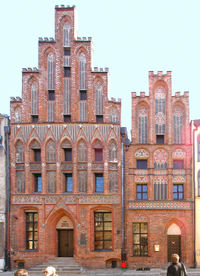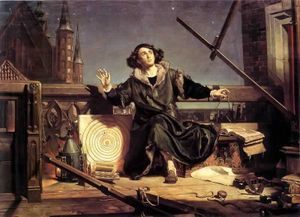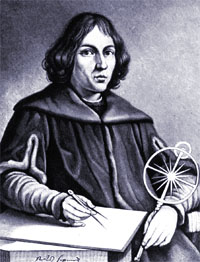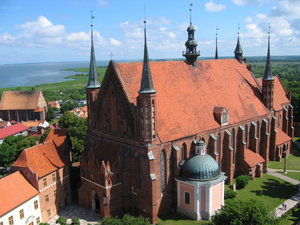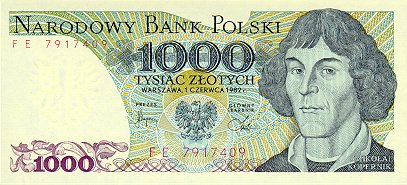Nicolaus Copernicus
2007 Schools Wikipedia Selection. Related subjects: Astronomers and physicists
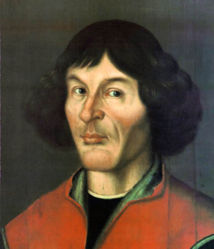 Portrait from Toruń, beginning of 16th century. |
|
| Born | February 19, 1473 Toruń (Thorn), Royal Prussia, ( Kingdom of Poland) |
|---|---|
| Died | May 24, 1543 Frombork (Frauenburg), Ermeland, ( Kingdom of Poland) |
| Residence | Poland, Italy |
| Field | Mathematician, Astronomer |
| Alma Mater | Cracow Academy (today the Jagiellonian University) |
| Known for | The first modern formulation of a heliocentric (sun-centered) theory of the solar system. |
| Religion | Roman Catholic |
Nicolaus Copernicus ( February 19, 1473 – May 24, 1543) was an astronomer who provided the first modern formulation of a heliocentric (sun-centered) theory of the solar system in his epochal book, De revolutionibus orbium coelestium (On the Revolutions of the Celestial Spheres).
Copernicus was one of the great polymaths of the Renaissance. He was a mathematician, astronomer, jurist, physician, classical scholar, governor, administrator, diplomat, economist and soldier. He was a Catholic cleric during most of his life too. Amid his extensive responsibilities, he treated astronomy as an avocation. However, his formulation of how the sun rather than the earth is at the centre of the solar system is considered one of the most important scientific hypotheses in history. It came to mark the starting point of modern astronomy and, in turn, of modern science.
Biography
Copernicus was born in 1473 in the city of Toruń (German: Thorn), in Royal Prussia, an autonomous province of the Kingdom of Poland. He was educated in Poland and Italy, and spent most of his working life in Frombork (Frauenburg), Warmia, where he died in 1543.
When he was ten years old, his father, a wealthy businessman, copper trader, and respected citizen of Toruń, died. Little is known of Copernicus' mother, Barbara Watzenrode, who appears to have predeceased her husband. Copernicus' maternal uncle, Lucas Watzenrode, a church canon and later Prince-Bishop governor of the Archbishopric of Warmia, reared him and his three siblings after the death of his father. His uncle's position helped Copernicus in the pursuit of a career within the Church, enabling him to devote much time to his astronomy studies. Copernicus had a brother and two sisters:
- Andreas became a Augustinian canon at Frombork (Frauenburg).
- Barbara became a Benedictine nun.
- Katharina married Barthel Gertner, a businessman and city councilor.
Education
In 1491, Copernicus enrolled at the Cracow Academy (today the Jagiellonian University), where he probably first encountered astronomy, taught by his teacher, Albert Brudzewski. This science soon fascinated him, as shown by his books, which would later be carried off as war booty by the Swedes, during "The Deluge", to the Uppsala University Library. After four years at Cracow, followed by a brief stay back home at Toruń, he went to Italy, where he studied law and medicine at the universities of Bologna and Padua. His bishop-uncle financed his education and wished for him to become a bishop as well. However, while studying canon and civil law at Ferrara, Copernicus met the famous astronomer, Domenico Maria Novara da Ferrara. Copernicus attended Novara's lectures and became his disciple and assistant. The first observations that Copernicus made in 1497, together with Novara, are recorded in Copernicus' epochal book, De revolutionibus orbium coelestium.
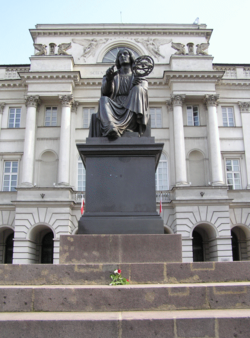
In 1497 Copernicus' uncle was ordained Bishop of Warmia, and Copernicus was named a canon at Frauenburg Cathedral, but he waited in Italy for the great Jubilee of 1500. Copernicus went to Rome, where he observed a lunar eclipse and gave some lectures in astronomy or mathematics.
He would thus have visited Frombork (Frauenburg) only in 1501. As soon as he arrived, he requested and obtained permission to return to Italy to complete his studies at Padua (with Guarico and Fracastoro) and at Ferrara (with Giovanni Bianchini), where in 1503 he received his doctorate in canon law. It has been surmised that it was in Padua that he encountered passages from Cicero and Plato about opinions of the ancients on the movement of the Earth, and formed the first intuition of his own future theory. It was in 1504 that Copernicus began collecting observations and ideas pertinent to his theory.
Work
Having left Italy at the end of his studies, he came to live and work at Frombork (Frauenburg). Some time before his return to Warmia, he had received a position at the Collegiate Church of the Holy Cross in Breslau, Silesia, which he would resign a few years before his death. Through the rest of his life, he performed astronomical observations and calculations, but only as time permitted and never in a professional capacity.
Copernicus worked for years with the Royal Prussian Diet on monetary reform and published studies on the value of money; as governor of Warmia, he administered taxes and dealt out justice. It was at this time (beginning in 1519, the year of Thomas Gresham's birth) that Copernicus formulated one of the earliest iterations of the theory that 'bad' (or debased) money will drive 'good' legal-tender money out of circulation, now known as " Gresham's Law." During these years, he also traveled extensively on government business and as a diplomat, on behalf of the Prince-Bishop of Warmia.
Heliocentric model
In 1514 he made his Commentariolus (Little Commentary) — a short handwritten text describing his ideas about the heliocentric hypothesis — available to friends. Thereafter he continued gathering data for a more detailed work. During the war between the Teutonic Order and the Kingdom of Poland ( 1519– 1524), Copernicus at the head of royal troops successfully defended Allenstein, besieged by the forces of Albert of Brandenburg.
In 1533, Johann Albrecht Widmannstetter delivered a series of lectures in Rome, outlining Copernicus' theory. These lectures were heard with interest by several Catholic cardinals and Pope Clement VII.
By 1536, Copernicus' work was nearing its definitive form, and rumors about his theory had reached educated people all over Europe. From many parts of the continent, Copernicus was urged to publish.
In a letter dated Rome, 1 November 1536, the Archbishop of Capua Nikolaus Cardinal von Schönberg asked Copernicus to communicate his ideas more widely and requested a copy for himself:
- "Therefore, learned man, without wishing to be inopportune, I beg you most emphatically to communicate your discovery to the learned world, and to send me as soon as possible your theories about the Universe, together with tables and whatever else you have pertaining to the subject."
It has been suggested that this letter may have made Copernicus leery of publication, while others have suggested that it indicated that the Church wanted to ensure that his ideas were published.
Despite urgings from many quarters, Copernicus delayed with the publication of his book — perhaps from fear of criticism delicately expressed in the " Dedication to Pope Paul III" associated with his great book. About this, historians of science David Lindberg and Ronald Numbers wrote:
- "If Copernicus had any genuine fear of publication, it was the reaction of scientists, not clerics, that worried him. Other churchmen before him — Nicole Oresme (a French bishop) in the fourteenth century and Nicolaus Cusanus (a German cardinal) in the fifteenth — had freely discussed the possible motion of the earth, and there was no reason to suppose that the reappearance of this idea in the sixteenth century would cause a religious stir." .
Publication of De revolutionibus orbium coelestium
Copernicus was still working on De revolutionibus (even if not convinced that he wanted to publish it) when in 1539 Georg Joachim Rheticus, a mathematician from Wittenberg, arrived in Frombork. Philipp Melanchthon had arranged for Rheticus to visit several astronomers and study with them. Rheticus became a pupil of Copernicus, staying with him for two years, during which he wrote a book, Narratio prima (First Account), outlining the essence of Copernicus' theory. In 1542, Rheticus published a treatise on trigonometry by Copernicus (later included in the second book of De revolutionibus). Under strong pressure from Rheticus, and having seen the favorable first general reception of his work, Copernicus finally agreed to give the book to his close friend, Tiedemann Giese, bishop of Chełmno (Kulm), to be delivered to Rheticus for printing by Johannes Petreius at Nuremberg (Nürnberg).
Legend has it that the first printed copy of De revolutionibus was placed in Copernicus' hands on the very day he died, allowing him to take farewell of his opus vitae (life's work). He is reputed to have woken from a stroke-induced coma, looked at his book, and died peacefully.
Copernicus was buried in Frombork Cathedral. Archeologists had long searched vainly for his remains when, on November 3, 2005, it was announced that in August that year Copernicus' skull had been discovered (see "Grave" below).
The Copernican heliocentric system
Earlier theories
Much has been written about earlier heliocentric theories. Early traces of a heliocentric model are found in several Vedic Sanskrit texts composed in ancient India before the 7th century BC: the Vedas, Aitareya Brahmana and Shatapatha Brahmana. The 1st century Sanskrit commentary Vishnu Purana elaborates on these earlier heliocentric concepts. Philolaus ( 4th century BC) was also one of the first to hypothesize movement of the Earth, probably inspired by Pythagoras' theories about a spherical Globe.
Aristarchus of Samos in the 3rd century BC had developed some theories of Heraclides Ponticus (speaking of a revolution by Earth on its axis) to propose what was, so far as is known, the first serious model of a heliocentric solar system. His work about a heliocentric system has not survived, so one may only speculate about what led him to his conclusions. It is notable that, according to Plutarch, a contemporary of Aristarchus accused him of impiety for "putting the Earth in motion."
Aryabhata in India anticipated Copernicus' discoveries by over 1,000 years and formulated a heliocentric model in which the Earth was taken to be spinning on its axis and the periods of the Earth and the planets were given with respect to a stationary Sun. He was also the first to discover that the light from the Moon and the planets were reflected from the Sun, and that the planets follow an elliptical orbit around the Sun. The 14th-century Arab astronomer ibn al-Shatir developed mathematical techniques similar to those used by Copernicus, and it has been suggested that Copernicus might have been influenced by them.
Copernicus cited Aristarchus and Philolaus in an early manuscript of his book which survives, stating: "Philolaus believed in the mobility of the earth, and some even say that Aristarchus of Samos was of that opinion." For reasons unknown (although possibly out of reluctance to quote pre-Christian sources), he did not include this passage in the publication of his book. Inspiration came to Copernicus not from observation of the planets, but from reading two authors. In Cicero he found an account of the theory of Hicetas. Plutarch provided an account of the Pythagoreans Heraclides Ponticus, Philolaus, and Ecphantes. These authors had proposed a moving earth, which did not, however, revolve around a central sun. Copernicus did not attribute his inspiration to Aristarchus as is sometimes stated. When Copernicus' book was published, it contained an unauthorized preface by the Lutheran theologian Andreas Osiander. This cleric stated that Copernicus wrote his heliocentric account of the earth's movement as a mere mathematical hypothesis, not as an account that contained truth or even probability. Since Copernicus' hypothesis was believed to contradict the Old Testament account of the sun's movement around the earth ( Joshua 10:13), this was apparently written to soften any religious backlash against the book. However, there is no evidence that Copernicus himself considered the heliocentric model as merely mathematically convenient, separate from reality.
It has been argued that in developing the mathematics of heliocentrism Copernicus drew on, not just the Greek, but the Islamic tradition of mathematics and astronomy, especially the works of Nasir al-Din Tusi, Mu’ayyad al-Din al-‘Urdi and ibn al-Shatir.
The Ptolemaic system
The prevailing theory in Europe as Copernicus was writing was that created by Ptolemy in his Almagest, dating from about 150 A.D.. The Ptolemaic system drew on many previous theories that viewed Earth as a stationary centre of the universe. Stars were embedded in a large outer sphere which rotated relatively rapidly, while the planets dwelt in smaller spheres between — a separate one for each planet. To account for apparent anomalies to this view, such as the retrograde motion observed in many planets, a system of epicycles was used, by which a planet rotated on a small axis while also rotating on a larger axis around the Earth.
A complementary theory to Ptolemy's employed homocentric spheres: the spheres within which the planets rotated, could themselves rotate somewhat. This theory predated Ptolemy (it was first devised by Eudoxus of Cnidus; by the time of Copernicus it was associated with Averroes). Also popular with astronomers were variations such as eccentrics — by which the rotational axis was offset and not completely at the centre.
Ptolemy's unique contribution to this theory was the idea of an equant — a complicated addition which specified that, when measuring the rotation of the Sun, one sometimes used the central axis of the universe, but sometimes a different axis. This had an overall effect of making certain orbits "wobble," a fact that would greatly bother Copernicus (such wobbling rendered implausible the idea of material "spheres" in which the planets rotated). In the end, after all these complications, the astronomers could still not get observation and theory to match up exactly. In Copernicus' day, the most up-to-date version of the Ptolemaic system was that of Peurbach (1423-1461) and Regiomontanus (1436-1476).
Copernican theory
Copernicus' major theory was published in the book, De revolutionibus orbium coelestium (On the Revolutions of the Celestial Spheres) in the year of his death, 1543, though he had arrived at his theory several decades earlier.
The book marks the beginning of the shift away from a geocentric (and anthropocentric) universe with the Earth at its centre. Copernicus held that the Earth is another planet revolving around the fixed sun once a year, and turning on its axis once a day. He arrived at the correct order of the known planets and explained the precession of the equinoxes correctly by a slow change in the position of the Earth's rotational axis. He also gave a clear account of the cause of the seasons: that the Earth's axis is not perpendicular to the plane of its orbit. He added another motion to the Earth, by which the axis is kept pointed throughout the year at the same place in the heavens; since Galileo Galilei, it has been recognized that for the Earth not to point to the same place would have been a motion.
Copernicus also replaced Ptolemy's equant circles with more epicycles. This is the main source of the statement that Copernicus' system had even more epicycles than Ptolemy's. With this change, Copernicus' system showed only uniform circular motions, correcting what he saw as the chief inelegance in Ptolemy's system. But while Copernicus put the Sun at the centre of the celestial spheres, he did not put it at the exact centre of the universe, but near it.
Copernicus' system was not experimentally better than Ptolemy's model. Copernicus was aware of this and could not present any observational "proof" in his manuscript, relying instead on arguments about what would be a more complete and elegant system. From publication until about 1700, few astronomers were convinced by the Copernican system, though the book was relatively widely circulated (around 500 copies are known to still exist, which is a large number by the scientific standards of the time). Many astronomers, however, accepted some aspects of the theory at the expense of others, and his model did have a large influence on later scientists such as Galileo and Johannes Kepler, who adopted, championed and (especially in Kepler's case) sought to improve it. Galileo's observation of the phases of Venus produced the first observational evidence for Copernicus' theory.
The Copernican system can be summarized in seven propositions, as Copernicus himself collected them in a Compendium of De revolutionibus that was found and published in 1878.
The seven parts of Copernicus' theory are:
- There is no one centre in the universe
- The Earth's center is not the centre of the universe
- The centre of the universe is near the sun
- The distance from the Earth to the sun is imperceptible compared with the distance to the stars
- The rotation of the Earth accounts for the apparent daily rotation of the stars
- The apparent annual cycle of movements of the sun is caused by the Earth revolving around the sun
- The apparent retrograde motion of the planets is caused by the motion of the Earth, from which one observes
Whether these propositions were "revolutionary" or "conservative" was a topic of debate in the late twentieth century. Thomas Kuhn argued that Copernicus only transferred "some properties to the sun's many astronomical functions previously attributed to the earth." Other historians have since argued that Kuhn underestimated what was "revolutionary" about Copernicus' work, and emphasized the difficulty Copernicus would have had in putting forward a new astronomical theory relying alone on simplicity in geometry, given that he had no experimental evidence.
Arthur Koestler puts Copernicus in a different light to what many authors seem to suggest, portraying him as a coward who was reluctant to publish his work due to a crippling fear of ridicule.
De revolutionibus orbium coelestium
Copernicus' major work, (Six books) On the Revolutions of the Heavenly Spheres (first edition 1543 in Nuremberg, second ed. 1566 in Basel), was the result of decades of labor. It opened with an originally anonymous preface by Andreas Osiander, a theologian friend of Copernicus, who urged that the theory, which was considered a tool that allows simpler and more accurate calculations, did not necessarily have implications outside the limited realm of astronomy.
Copernicus' actual book began with a letter from his (by then deceased) friend Nikolaus Cardinal von Schönberg, the Archbishop of Capua, urging Copernicus to publish his theory. Then, in a lengthy introduction, Copernicus dedicated the book to Pope Paul III, explaining his ostensible motive in writing the book as relating to the inability of earlier astronomers to agree on an adequate theory of the planets, and noting that if his system increased the accuracy of astronomical predictions it would allow the Church to develop a more accurate calendar. At that time, a reform of the Julian Calendar was considered necessary and was one of the major reasons for Church funding of astronomy.
The work itself was then divided into six books:
- General vision of the heliocentric theory, and a summarized exposition of his idea of the World
- Mainly theoretical, presents the principles of spherical astronomy and a list of stars (as a basis for the arguments developed in the subsequent books)
- Mainly dedicated to the apparent motions of the Sun and to related phenomena
- Description of the Moon and its orbital motions
- Concrete exposition of the new system
- Concrete exposition of the new system (continued)
Copernicus and Copernicanism
Copernicus' theory is of extraordinary importance in the history of human knowledge. Many authors suggest that only a few other persons have exerted a comparable influence on human culture in general and on science in particular.
Many meanings have been ascribed to Copernicus' theory, apart from its strictly scientific import. His work affected religion as well as science, dogma as well as freedom of scientific inquiry. Copernicus' rank as a scientist is often compared with that of Galileo.
Copernicus' work contradicted then-accepted religious dogma: it could be inferred that there was no need of an entity (God) that granted a soul, power and life to the World and to human beings — science could explain everything that was attributed to Him.
Copernicanism, however, also opened a way to immanence, the view that a divine force, or a divine being, pervades all things that exist — a view that has since been developed further in modern philosophy. Immanentism also leads to subjectivism: to the theory that it is perception that creates reality, that there is no underlying reality that exists independent of perception. Thus some argue that Copernicanism demolished the foundations of medieval science and metaphysics.
A corollary of Copernicanism is that scientific law need not be congruent with appearance. This contrasts with Aristotle's system, which placed much more importance on the derivation of knowledge through the senses.
Copernicus' concept marked a scientific revolution. The publication of his De revolutionibus orbium coelestium is often taken to be the beginning of the Scientific Revolution, together with the publication of the De Humani Corporis Fabrica by Andreas Vesalius .
Quotes
Goethe:
- "Of all discoveries and opinions, none may have exerted a greater effect on the human spirit than the doctrine of Copernicus. The world had scarcely become known as round and complete in itself when it was asked to waive the tremendous privilege of being the centre of the universe. Never, perhaps, was a greater demand made on mankind — for by this admission so many things vanished in mist and smoke! What became of our Eden, our world of innocence, piety and poetry; the testimony of the senses; the conviction of a poetic — religious faith? No wonder his contemporaries did not wish to let all this go and offered every possible resistance to a doctrine which in its converts authorized and demanded a freedom of view and greatness of thought so far unknown, indeed not even dreamed of."
- "I was pleased to think of the right of the Polish nobleman to upset with its simple veto the resolution of a (parliament) meeting; and the Pole Copernikus seemed to have made from this right against the resolution and all appearances of other people the largest and worthiest use."
Copernicus:
- "For I am not so enamored of my own opinions that I disregard what others may think of them. I am aware that a philosopher's ideas are not subject to the judgment of ordinary persons, because it is his endeavor to seek the truth in all things, to the extent permitted to human reason by God. Yet I hold that completely erroneous views should be shunned. Those who know that the consensus of many centuries has sanctioned the conception that the earth remains at rest in the middle of the heaven as its centre would, I reflected, regard it as an insane pronouncement if I made the opposite assertion that the earth moves.
- "For when a ship is floating calmly along, the sailors see its motion mirrored in everything outside, while on the other hand they suppose that they are stationary, together with everything on board. In the same way, the motion of the earth can unquestionably produce the impression that the entire universe is rotating.
- "Therefore alongside the ancient hypotheses, which are no more probable, let us permit these new hypotheses also to become known, especially since they are admirable as well as simple and bring with them a huge treasure of very skillful observations. So far as hypotheses are concerned, let no one expect anything certain from astronomy, which cannot furnish it, lest he accept as the truth ideas conceived for another purpose, and depart from this study a greater fool than when he entered it. Farewell."
Declaration of the Polish Senate issued on 12th of June 2003.
- "At the time of five hundred and thirtieth anniversary of the birth and four hundred sixtieth anniversary of the death of Mikołaj Kopernik, the Senate of the Republic of Poland expresses its highest respect and praise for this exceptional Pole, one of the greatest scientists in the history of the world. Mikołaj Kopernik, world-famous astronomer and author of the breakthrough work De revolutionibus orbium coelestium, is the one who "Held the Sun and moved the Earth". He distinguished himself for the country as exceptional mathematician, economist, lawyer, doctor and priest, as well as defender of the Olsztyn Castle during Polish-Teutonic war. May the memory of his achievements endure and be a source of inspiration for future generations."
Allgemeine Deutsche Biographie: ADB, published between 1875 and 1912, Seite 465
- "The nationality question was a subject of different writings; an honouring controversy over the claim to the founder of our current world view is led between Poles and Germans, but it is already mentioned that over the nationality of parents of the Copernicus nothing sure could be determined; the father seems to be of Slavic birth, the mother to be a German; he was born in a city, whose municipal authorities and educated inhabitants were Germans, which however at present of his birth was under Polish rule; he studied in Krakau in the Polish capital, then in Italy and lived to his end in Frauenburg as a capitular; he wrote Latin and German. In the science he is a man, who does not belong to a nation, his working, his striving belongs to the whole world, and we do not honour the Pole, not the German, in Copernicus but the man of free spirit, the great astronomer, the father of the new astronomy, the author of the true world view."
Johannes Rau (at that time President of Germany) addresses the Polish people in 1999:
- "Poles and Germans have a common history of great scientists: Today we no longer perceive Copernicus, Hevelius, Schopenhauer, and Fahrenheit as the property of one nation but as representatives of one transnational culture."
Grave
In August 2005, a team of archeologists led by Jerzy Gąssowski, head of an archaeology and anthropology institute in Pułtusk, discovered what they believe to be Copernicus' grave and remains, after scanning beneath the floor of Frombork Cathedral. The find came after a year of searching, and the discovery was announced only after further research, on November 3. Gąssowski said he was "almost 100 percent sure it is Copernicus".
Forensic expert Capt. Dariusz Zajdel of the Central Forensic Laboratory of the Polish Police used the skull to reconstruct a face that closely resembled the features — including a broken nose and a scar above the left eye — on a Copernicus self-portrait . The expert also determined that the skull had belonged to a man who had died about age 70 — Copernicus' age at the time of his death.
The grave was in poor condition, and not all the remains were found. The archeologists hoped to find deceased relatives of Copernicus in order to attempt DNA identification.
Historical background to the question of Copernicus' nationality
It remains to this day a matter of dispute whether Copernicus should be called German or Polish.
Copernicus' father, likewise named Nicolaus, might have had the surname Koppernigk, which could have been derived from a village in Silesia near Nysa (Neiße) which was called Köppernig until 1945, and is called Koperniki since. A Polish theory says that the original ending –nik in Copernicus' name indicates its Polish form, meaning a person who works with copper . The Polish modern word for copper is Miedź, though, while the German is Kupfer. However, "Kopernik" may as well refer to a Polish word "koper" which stands for a herb - fennel(Foeniculum vulgare)
In the title of his famous book, his name is written as "Nicolai Copernici Torinensis De Revolutionibus Orbium Coelestium, Libri VI", roughly meaning "Nicolaus' Copernicus' of Torin six books on ...". In the German: Nikolaus Kopernikus, each C was substituted with K to clarify pronunciation (not Z as in the German pronunciation of Cicero or Caesar). In Poland, Polish: Mikołaj Kopernik is used (or claimed to be his original name).
The father of Copernicus, possibly a Germanized Slav , had been a citizen of Cracow, but left the (then) capital of Poland in 1460 to move to Thorn/Toruń (German/Polish). That Hanseatic city was also part of the Prussian Confederation, which, some decades before Copernicus' birth, had tried to gain independence from the Teutonic Knights who had ruled the area for two hundred years, but imposed high taxes that were hindering economic development. This led to the Thirteen Years' War and the Second Treaty of Thorn of 1466: Thorn/Toruń and Prussia's western part, called " Royal Prussia", became connected to the Kingdom of Poland, which had supported the uprising, while the eastern part remained under the administration of the Teutonic Order, later to become " Ducal Prussia". Thus the child of a German family was a subject of the Polish crown. Copernicus was born and has grown up in Thorn/Toruń, and was certainly fluent in the German language, while no direct evidence survives of the extent to which he knew the Polish language. His main language for written communication was Latin.
After his prolonged studies in Italy, Copernicus spent most of his working life as a cleric in Royal Prussia, which enjoyed substantial autonomy as part of the lands of the Polish Crown — it had its own Diet, monetary unit and treasury (which Copernicus famously helped to place on a sound footing) and army. Copernicus also oversaw the defense of Olsztyn/ Allenstein at the head of Polish royal forces when the local castle was besieged by the forces of Albrecht I Hohenzollern von Brandenburg-Ansbach, the future ( Protestant) Duke of Prussia. He became for the rest of his life a burgher of Prussian Ermland ( Bishopric of Warmia), and was a loyal subject of the Catholic Prince-Bishops and the Catholic Polish king during the Protestant Reformation in which many parts of Germany, starting with Ducal Prussia, became Protestant.
In 1757 Copernicus's book was removed from the Index Librorum Prohibitorum, the list of books which were banned by the Catholic Church. Ever since, Poles claimed that Copernicus was a Pole and Germans that he was a German. Before that, when Copernicus and his ideas were rejected, it was contrariwise . A bust of Copernicus is enshrined since 1842 in the Walhalla, German Hall of Fame. In Nazi Germany attempts were made to claim that Copernicus was exclusively a German; however, after 1945 those attempts have greatly diminished. Despite the acknowledgement of his connections to Poland he is certainly not considered in Germany as Un-German or Non-German either. In 2003 he was declared eligible for the Unsere Besten ranking of outstanding Germans.
In Poland, on the other hand, his 500th birthday was celebrated in 1973, emphasizing his Polishness. A banknote with an image of Copernicus was issued, and the Polish Senate called him on 12 June 2003 an "exceptional Pole".
Today he is often classified as Polish, in part based on the location of his birthplace in then and present-day Poland, though not only limited to that. It must be remembered though that during Copernicus' lifetime, nationality was yet to play as important a role as it would later, and people generally did not think of themselves primarily as Poles or Germans. In fact, Copernicus might have considered himself to be both at the same time.
